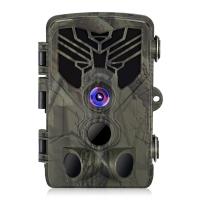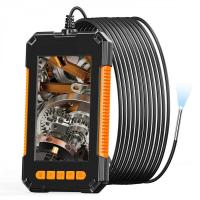Low Glow Vs No Glow Trail Camera
- days
- :
- hours
- :
- min
- :
- sec
- * KF35.133 =KF35.127S1=KF35.127V1+KF28.0011*2+KF42.0013 Low Glow: Brighter night vision up to 65ft/20m:Low glow trail cameras have a visible flash that produces brighter night vision images compared to no glow trail cameras. This is especially useful when monitoring larger areas or when trying to capture images of fast-moving animals.
- * No Glow: Stealthy and undetectable:No glow trail cameras are completely invisible to both humans and animals, making them ideal for security purposes or for capturing images of shy or nocturnal animals without disturbing them.
- * Low Glow: Longer battery life:Low glow trail cameras consume less power compared to no glow trail cameras, resulting in longer battery life. This is especially useful when monitoring remote areas where access to power sources is limited.
- * No Glow: Better image quality:No glow trail cameras produce sharper and clearer images compared to low glow trail cameras, as they do not have a visible flash that can cause glare or wash out the image.
- * Both: Versatile monitoring period setting:Both low glow and no glow trail cameras have a monitoring period setting that can be adjusted from 0-24 hours, allowing users to customize their monitoring schedule according to their needs. Additionally, both cameras have WIFI and Bluetooth capabilities for remote access and control up to 20 meters outside.
2. Get free gift over $100 (select on the checkout page).
3. Get a 20% OFF code after ordered (Each account may only participate once).
Low glow trail cameras use infrared flash to capture images at night, which emits a faint red glow that is barely visible to the human eye. No glow trail cameras, on the other hand, use black infrared flash, which is completely invisible to both humans and animals. While low glow cameras may be slightly more visible, they generally have a longer flash range and better image quality than no glow cameras. However, if you are concerned about spooking game or want to be completely stealthy, a no glow camera may be the better option. Ultimately, the choice between a low glow and no glow trail camera depends on your specific needs and preferences.

Product Advantages:
1. Low Glow Trail Camera: Low glow trail cameras are equipped with infrared flash that emits a faint red glow when triggered. This feature makes them ideal for capturing images and videos in low light conditions without spooking the game. The low glow flash is less visible to animals, making them less likely to be scared away.
2. No Glow Trail Camera: No glow trail cameras are equipped with black infrared flash that is completely invisible to both humans and animals. This feature makes them ideal for capturing images and videos of game without alerting them to the presence of the camera. The no glow flash is undetectable to animals, making them more likely to return to the area.
3. Advantages of Low Glow Trail Camera: Low glow trail cameras are ideal for capturing images and videos in low light conditions. They are also less expensive than no glow trail cameras. The low glow flash is less visible to animals, making them less likely to be scared away. This makes them ideal for capturing images and videos of game without alerting them to the presence of the camera.
4. Advantages of No Glow Trail Camera: No glow trail cameras are ideal for capturing images and videos of game without alerting them to the presence of the camera. They are also more expensive than low glow trail cameras. The no glow flash is undetectable to animals, making them more likely to return to the area. This makes them ideal for capturing images and videos of game without spooking them.

Common problems:
1. Error: The low glow trail camera produces visible red light when taking pictures or videos at night, which may scare away animals or alert trespassers. Solution: Switch to a no glow trail camera that uses black infrared technology to capture images without emitting any visible light.
2. Error: The no glow trail camera produces blurry or grainy images at night due to the lack of visible light. Solution: Adjust the camera settings to increase the exposure time, ISO sensitivity, or flash range, or use an external infrared illuminator to provide additional light.
3. Error: The low glow trail camera fails to capture clear images or videos in low light conditions, such as dawn or dusk. Solution: Use a camera with a higher aperture or larger image sensor, or add a supplemental light source to improve the visibility.
4. Error: The no glow trail camera drains the battery quickly due to the high power consumption of the infrared LEDs. Solution: Use a camera with a low power consumption mode or a larger battery capacity, or use rechargeable batteries to save costs.
5. Error: The low glow trail camera triggers false alarms or misses actual events due to the slow trigger speed or motion detection sensitivity. Solution: Use a camera with a faster trigger speed or more advanced motion detection algorithm, or adjust the placement and angle of the camera to avoid false triggers.
6. Error: The no glow trail camera is difficult to set up or operate due to the complex menu or user interface. Solution: Choose a camera with a simple and intuitive interface, or read the user manual carefully before using the camera.

Product features:
1. Flash Type: One of the most significant differences between low glow and no glow trail cameras is the type of flash they use. Low glow cameras use a dim red glow flash that is visible to the human eye, while no glow cameras use an infrared flash that is invisible to the human eye. This feature is essential for hunters who do not want to spook game animals with a visible flash.
2. Image Quality: Both low glow and no glow trail cameras offer high-quality images, but no glow cameras tend to produce better quality images. This is because the infrared flash used by no glow cameras does not produce the same amount of light as the low glow flash, which can cause overexposure and wash out the image.
3. Battery Life: No glow trail cameras tend to have a longer battery life than low glow cameras. This is because the infrared flash used by no glow cameras requires less power than the low glow flash used by low glow cameras. This feature is essential for hunters who want to leave their cameras in the field for an extended period without having to change the batteries frequently.
4. Price: No glow trail cameras tend to be more expensive than low glow cameras. This is because the technology used in no glow cameras is more advanced and requires more expensive components. However, the price difference is not significant, and hunters should consider the features they need before making a purchase.

Related accessories:
1. Low Glow Trail Camera: A low glow trail camera is an accessory that is designed to capture images and videos in low light conditions. It uses infrared technology to illuminate the area and capture clear images without spooking the wildlife. The low glow feature emits a faint red glow that is barely visible to the human eye, making it ideal for use in areas where you don't want to attract attention.
2. No Glow Trail Camera: A no glow trail camera is an accessory that is designed to capture images and videos without emitting any visible light. It uses black infrared technology to capture clear images without spooking the wildlife. The no glow feature emits no visible light, making it ideal for use in areas where you want to remain undetected.
3. Camera Tripod: A camera tripod is an accessory that provides stability and support for your camera. It allows you to take steady shots and eliminates camera shake, resulting in sharper images and videos.
4. Camera Lens: A camera lens is an accessory that can enhance the quality of your images and videos. It allows you to zoom in and out, adjust the focus, and capture more detail.
5. Camera Bag: A camera bag is an accessory that provides protection and storage for your camera and accessories. It keeps your equipment safe from damage and makes it easy to transport.
6. Camera Strap: A camera strap is an accessory that allows you to carry your camera comfortably and securely. It distributes the weight of the camera evenly across your body, reducing strain on your neck and shoulders.

Product parameters:
Monitoring period setting : 0-24 hours
APP name : TrailCamera Wifi
Microphone & Speaker : Support
PIR sensing angle : 120 degrees
WIFI distance : 20 meters outside
Exposure control : Automatic
LCD display : 2.0" IPS 320×240(RGB) DOT
Bluetooth distance : 20 meters outside
Time watermark function : Support
Fill light irradiation distance : 65ft/20m
- All Reviews
- Image






















